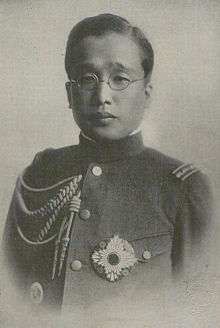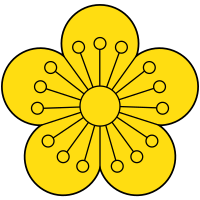Yi Un
Lieutenant General Prince Imperial Yeong, Yi Un, Crown Prince Uimin (also Euimin), also known as Yi Un, Yi Eun, Lee Eun and Un Yi (20 October 1897 – 1 May 1970), was the 28th Head of the Korean Imperial House, an Imperial Japanese Army general and the last crown prince of Korea. In 1910, when the Empire of Korea was annexed by Japan and Emperor Sunjong was forced to abdicate, Yi Un was titled His Highness The Crown Prince of Korea. On 10 June 1926, upon the death of Emperor Sunjong, he became His Highness Great Prince Yi of the Ch'angdŏk Palace in Japan. After World War II he was refused entry to Korea, and his Japanese titles were removed by article 14 of the new Constitution of Japan in 1947.
| Yi Un | |||||||||
|---|---|---|---|---|---|---|---|---|---|
| Crown Prince of Korea | |||||||||
 | |||||||||
| Head of the House of Yi | |||||||||
| Period | 24 April 1926 – 1 May 1970 | ||||||||
| Predecessor | Emperor Sunjong I | ||||||||
| Successor | Crown Prince Yi Gu | ||||||||
| Born | 20 October 1897 Deoksu Palace, Seoul, Empire of Korea | ||||||||
| Died | 1 May 1970 (aged 72) Nakseon Hall, Changdeok Palace, Seoul, Republic of Korea | ||||||||
| Burial | |||||||||
| Spouse | |||||||||
| Issue | Prince Yi Jin Crown Prince Yi Gu of Korea | ||||||||
| |||||||||
| House | Yi | ||||||||
| Father | Emperor Gojong I of Korea | ||||||||
| Mother | Eom Seon-yeong | ||||||||
| Yi Un | |
| Hangul | 의민태자 |
|---|---|
| Hanja | 懿愍太子 |
| Revised Romanization | Uimin Taeja |
| McCune–Reischauer | Ŭimin T'aeja |
| Birth name | |
| Hangul | 이은 |
| Hanja | 李垠 |
| Revised Romanization | I Eun |
| McCune–Reischauer | Yi Ŭn |
| Imperial title | |
| Hangul | 영친왕 |
| Hanja | 英親王 |
| Revised Romanization | Yeongchinwang* |
| McCune–Reischauer | Yŏngch'inwang |
| |
In 1920, he married Princess Masako of Nashimoto (born 4 November 1901 – 30 April 1989 (aged 87)), the eldest daughter of Prince Nashimoto Morimasa, on 28 April 1920 at Tokyo.
Early life

The prince was born on 20 October 1897 at Deoksu Palace in Seoul as the seventh son of Gojong, the Gwangmu Emperor. His mother was the Honorable Princess Consort Eom Seon-yeong, a palace attendant, who was posthumously awarded the title of Princess Sunheon. He was also the younger half-brother of Emperor Sunjong and Prince Imperial Ui. He was titled Prince Imperial Yeong in 1900, and became the crown prince in 1907, despite being younger than Prince Ui. Prince Ui's support base at court was not strong because his own mother, Lady Jang, had already died.
In December 1907, he was taken to Japan on the initiative of Itō Hirobumi to be enrolled at Gakushūin Peers' School. The move was meant to ensure that the Korean royal family would not take any further anti-Japanese actions following The Hague Secret Emissary Affair.[1] Japanese Emperor Meiji, who largely ignored his own grandchildren, devoted a lot of attention to Yi Un, acting as his guardian.[2]. Itō would bring Yi Un whenever he was visiting the princes Hirohito, Chichibu and Takamatsu.[3] Meiji apparently stopped seeing Yi Un so frequently after Ito's assassination.[4] Yi Un was allowed to visit Korea again only after the death of his mother in 1911.[5]
Military career


In September 1911, the prince was enrolled in the second year of the Army Central Youth School, a military preparation school located in Tokyo. He was poor in gymnastics due to his small statue, but excelled in music and martial arts. He was then enrolled in the 29th class of the Imperial Japanese Army Academy, from which he graduated on 25 May 1917 with an excellent record.
He was commissioned a second lieutenant in the infantry on 25 December, and steadily rose up the ranks, receiving promotions to lieutenant (April 1920), and captain (July 1923). He graduated from the 35th class of the Army Staff College in November 1923 and commanded a battalion of the Guards 2nd Infantry Regiment. He was assigned to the Imperial Japanese Army General Staff Office in December 1924, and to the staff of the Chosen Army in July 1926. In May 1927, he was sent on an extensive European tour, visiting France, Switzerland, United Kingdom, Belgium, Netherlands, Germany, Denmark, Norway, Sweden, Poland, Austria, Czechoslovakia, Italy, Monaco, and returning to Japan in April 1928. In August, he was promoted to major and in August 1929 became commander of the IJA 1st Infantry Regiment. In December 1930, he was assigned to the Inspectorate General of Military Training and was promoted to lieutenant colonel in August 1932. He became colonel in August 1935 and commanded the Utsunomiya-based IJA 59th Infantry Regiment. From April 1937, he served as an instructor at the Army Academy.
In July 1938, the prince was promoted to major general and from December was assigned to the staff of the North China Area Army, which was engaged in combat operations in northern China following the start of the Second Sino-Japanese War. Throughout the first half of 1939, he made extensive inspection tours of front-line units throughout northern Japan, and reviewed Kwantung Army garrison units in Manchukuo. In August, he was appointed commander of the Guards 2nd Brigade and in May 1940 was commander of the reserve Fourth Depot Division. He was promoted to lieutenant general in December. In July 1941, he was appointed commander of the IJA 51st Division.
Under his command, the division relocated to Manchukuo to participate in the Special exercise of the Kwantung Army (actually a mobilization for the possible large-scale conflict with the Soviet Union). The preparations for the war with the Soviet Union were officially cancelled in August 1941. In September, the division was transferred to Guangdong under command of IJA 23rd Army. He returned to a post on the staff of the Inspectorate General of Military Training in November.
From August 1942, the prince was transferred to the Imperial Japanese Army Air Force and became commander of the 1st Air Army from July 1943. In April 1945, he became a member of the Supreme War Council [6]
Later life
Following the surrender of Japan, Yi Un lost his royal status under the American Occupation of Japan in 1947. He was also declared stateless, as Korea had become independent of the Empire of Japan, but Korean President Syngman Rhee had refused his request to be allowed to return to Korea with his family. In May 1957, following the end of the American occupation, he acquired Japanese citizenship and travelled to America the same month. In March 1959, while still in America, he suffered from a stroke. He returned to Japan in May. In 1960, President Rhee again denied him permission to return to Korea, but instead offered the prince the position of Korean Ambassador to the Court of St. James's. He refused on the grounds of illness, but made a trip to New York from June to August 1960, and to Hawaii from March to May 1961. His health deteriorating rapidly, he was hospitalized in Tokyo from August 1961.
In November 1963, President Park Chung-hee granted permission for Prince Yi Eun and Crown Princess Bangja to return to Korea. By that time, Prince Yi Eun was unconscious from cerebral thrombosis. He received treatment at St. Mary's Hospital in Seoul.
In his final years, Prince Yi Eun lived at Nakseon Hall, Changdeokgung Palace, the former residence of the Korean Imperial Family in Seoul, with Bangja and his younger sister Princess Deokhye. Seven years after returning to his country, he died on 1 May 1970 at Nakseon Hall, Changdeok Palace, Seoul. He was buried at Hongreung in Namyangju, near Seoul; he is known posthumously as Yi Un, Crown Prince Euimin of Korea.
Children
- Yi Jin (Korean: 이진; Hanja: 李晋; RR: I Jin) (born 18 August 1921 – 11 May 1922 (aged 0)), the elder son of Prince Eun and his wife, Princess Bangja. He died abruptly during a visit to Korea with his parents, fueling conspiracy theories. His funeral was held on 17 May 1922 and he is buried in Korea. No issue.
- Yi Gu (Korean: 이구; Hanja: 李玖; RR: I Gu) (born 29 December 1929 – 16 July 2005 (aged 75)), the second son of Prince Eun and his wife, Princess Bangja. Prince Gu became the 29th Head of the Korean Imperial Household upon the death of his father. He married Julia Mullock, an American citizen (b. 1928) on 25 October 1959 at St George's Church in New York, they had no issue but adopted a daughter, Eugenia Unsuk Lee (Eun-sook) (b. 1959).
Titles, styles and honours
- Titles and styles
- 1897–1900: His Royal Highness Prince Yi Un of Korea
- 1900–1907: His Imperial Highness Prince Imperial Yeong of Korea
- 1907–1910: His Imperial Highness Crown Prince Yi Un of Korea
- 1910–1926: His Highness Crown Prince Yi Un of Korea
- 1926–1947: His Highness Great Prince Yi of the Ch'angdŏk Palace
- 1947–1970: Yi Un
- In pretence
- 1910–1970: His Imperial Highness Crown Prince Yi Un of Korea
- Posthumously: His Majesty King Yi Un of Korea
- Honours
.svg.png)
- Grand Order of the Golden Ruler – 1901
- Grand Order of the Auspicious Stars – 1901
- Grand Order of the Plum Blossoms – 1901
.svg.png)
- Order of the Chrysanthemum, Grand Cordon – 27 April 1920
- Order of the Rising Sun, Grand Cordon with Paulownia Flowers
- Order of the Sacred Treasure, Grand Cordon
- Order of the Golden Kite, 3rd class – 20 March 1942
.svg.png)


_crowned.svg.png)




References
- Herbert P. Bix, Hirohito and the making of modern Japan (New York 2016), page 35.
- Herbert P. Bix, Hirohito and the making of modern Japan (New York 2016), page 35.
- Herbert P. Bix, Hirohito and the making of modern Japan (New York 2016), page 35.
- Herbert P. Bix, Hirohito and the making of modern Japan (New York 2016), page 697, note 38.
- Herbert P. Bix, Hirohito and the making of modern Japan (New York 2016), page 35.
- Ammentorp, Steen. "Generals from Japan, Yi, part of Generals of WWII". Retrieved 26 August 2016.
- Bille-Hansen, A. C.; Holck, Harald, eds. (1933) [1st pub.:1801]. Statshaandbog for Kongeriget Danmark for Aaret 1933 [State Manual of the Kingdom of Denmark for the Year 1933] (PDF). Kongelig Dansk Hof- og Statskalender (in Danish). Copenhagen: J.H. Schultz A.-S. Universitetsbogtrykkeri. p. 21. Retrieved 16 September 2019 – via da:DIS Danmark.
- Sveriges statskalender (in Swedish), 2, 1931, p. 148, retrieved 2018-01-06 – via runeberg.org
External Links
| Wikimedia Commons has media related to Yi Un. |
Yi Un Born: 20 October 1897 Died: 1 May 1970 | ||
| Titles in pretence | ||
|---|---|---|
| Preceded by Emperor Yunghui |
— TITULAR — Emperor of Korea Korean Empire 24 April 1926 – 1 May 1970 Reason for succession failure: Empire abolished in 1910 |
Succeeded by Gu, Prince Imperial Hoeun |

.svg.png)